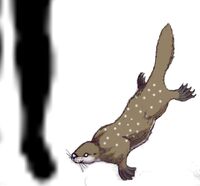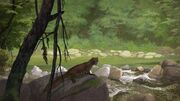The Waitoreke (or Waitoreki, Waitorete) is an otter/beaver-like cryptid said to live in New Zealand. It is usually described as a small otter-like animal that lives in the South Island of New Zealand. There are many theories on the Waitoreke's true identity, such as it being an otter, beaver or pinniped. The Waitoreke is usually described as a small otter-like creature sometimes as big as a cat. It is described as having brownish fur and short legs. The sightings usually place the creature near or in the water on the South Island of New Zealand. Its fur is described as being short like that of an otter. At least some reports listing attributes claim the creature has a spur on its heel, similar to those seen in monotreme mammals like the platypus and echidna. Very little physical evidence proving the existence of the Waitoreke exists. Julius von Haast is reported to have obtained a Waitoreke pelt in 1868. The fur was brown, with white spots, and the toes lacked webbing. This is inconclusive evidence; the pelt seems to have resembled a quoll's.
A Tiger Quoll, a possible explanation for Waitoreke sightings.
Quolls are sometimes claimed to have been released in New Zealand in 1858. The Common Brushtail Possum was successfully introduced in 1858 and is now a widespread pest, whereas introduction of the Common Ringtail Possum ultimately failed. Both animals are unspotted. It is possible that it was a quoll pelt and the introduction was not documented, as in the 1800s quolls were considered a type of possum. While quolls are not found in New Zealand today, it is possible if an introduction occurred in 1858, the same time as the possum introduction, that a few stragglers survived for at least ten years and this accounted for the 1868 pelt Haast collected. "Evidence" for the existence of the Waitoreke is mainly based on sporadic accounts of an "unidentified amphibious animal" in the country's South Island spanning well over 200 years. Some of the more infamous accounts are dubious and/or incongruous - but a significant number of descriptions (particularly from the late 19th century onwards) share a striking similarity to each other and to species known to exist outside New Zealand. The Māori people said that in old times they used to keep waitoreke as pets.
There's a possibility that prehistoric Saint Bathans Mammal, known from fragmentary fossils, that inhabited New Zealand in Miocene is the Waitoreke or its relative. The fossil indicates the island subcontinent' fauna was one quite different than it was in historic times. The only mammals found in New Zealand prior to the first Maori settlers were several types of bats and seals, no terrestrial animal groups. The Saint Bathans fossil however shows at least some type of land animal, and one unique to the region as it showed signs of belonging to a much more archaic group of mammals that is extinct elsewhere, did once roam the island. This possibility makes Waitoreke even more unique - because Saint Bathans Mammal was a very primitive one, related to multituberculates which went extinct elsewhere in the world roughly 33 million years ago.
It is possible the Waitoreke, if it was ever real, was a legitimately unknown species at one point. But, as with many species that once roamed New Zealand, if something unique and unknown was there it might have gone extinct in historic times before it could be documented more thoroughly. Subsequent sightings in the last hundred years or so are instead witnesses seeing an introduced species from other countries, with possums, quolls, beavers, and otters being the most likely. Given New Zealand was still being settled at the time and was relatively unexplored, combined with the plausible nature and small size of the reported creature, numerous critics and even skeptics of Cryptozoology have entertained the notion the Waitoreke is one of the most likely cryptids to have been real at least at some point.


